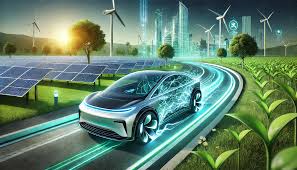Electric Vehicles in 2025: The Future of Sustainable Transportation
As we head into 2025, the world is witnessing a massive shift in the transportation sector. The growing need to combat climate change, reduce carbon emissions, and create more sustainable urban environments is driving an unprecedented transformation in the way we travel. At the forefront of this change is the electric vehicle (EV), which is rapidly gaining traction as the go-to solution for eco-friendly transportation. In this article, we’ll explore the future of electric vehicles in 2025 and the exciting innovations that will shape the next generation of sustainable mobility.
1. The Rise of Electric Vehicles: A Green Revolution
The push for electric vehicles has gained significant momentum in recent years, driven by the need to reduce greenhouse gas emissions and mitigate the environmental impact of traditional internal combustion engine (ICE) vehicles. By 2025, electric vehicles are expected to become even more mainstream, with advancements in technology, charging infrastructure, and government policies accelerating their adoption.
Governments around the world are setting ambitious targets for EV adoption, with many countries planning to ban the sale of new gasoline and diesel cars within the next few decades. The global shift towards electric vehicles is not only driven by environmental concerns but also by the growing demand for cleaner, more cost-effective transportation options.
Key Drivers of the Electric Vehicle Revolution:
- Environmental concerns: EVs produce zero tailpipe emissions, reducing air pollution and mitigating climate change.
- Government incentives: Many governments offer tax credits, rebates, and incentives to encourage the adoption of electric vehicles.
- Technological advancements: Improvements in battery technology, charging infrastructure, and vehicle design are making EVs more affordable and practical.
- Consumer demand: With rising awareness of environmental issues, consumers are increasingly looking for sustainable alternatives to traditional vehicles.
2. Battery Technology: The Heart of Electric Vehicles
One of the biggest challenges for electric vehicles has been battery technology. The energy density, charging speed, and overall lifespan of batteries have historically limited the range and convenience of EVs. However, as we approach 2025, significant advancements in battery technology are expected to overcome many of these limitations.
Solid-state batteries, which offer higher energy density and faster charging times than traditional lithium-ion batteries, are on the brink of commercialization. These next-generation batteries will not only improve the driving range of EVs but also reduce charging times, making electric cars as convenient as their gasoline-powered counterparts.
In addition to solid-state batteries, advancements in lithium-sulfur and lithium-air batteries could further enhance the performance of electric vehicles, offering even longer driving ranges and shorter charging times.
Future Developments in EV Battery Technology:
- Solid-state batteries: These batteries offer higher energy density, faster charging times, and greater safety compared to traditional lithium-ion batteries.
- Improved battery life: Enhanced battery management systems will increase the lifespan of EV batteries, reducing the need for replacements.
- Faster charging: New charging technologies will allow EVs to be charged in a matter of minutes, rivaling the speed of refueling a traditional car.
- Cost reduction: As battery production scales, the cost of EV batteries will decrease, making electric vehicles more affordable for consumers.
3. Charging Infrastructure: Making EVs More Accessible
One of the key factors limiting the widespread adoption of electric vehicles has been the lack of a comprehensive and convenient charging infrastructure. However, as we move towards 2025, this challenge is being addressed by both private companies and governments.
Charging networks are expanding rapidly, with new charging stations being installed at homes, businesses, public spaces, and along highways. Fast-charging stations, capable of delivering significant power to EVs in a short amount of time, are becoming more prevalent, allowing drivers to recharge their vehicles in minutes rather than hours.
In addition to traditional charging stations, wireless charging technology, where vehicles are charged without physical connectors, is also on the horizon. This could make charging even more seamless and convenient for drivers.
Key Developments in EV Charging Infrastructure:
- Expansion of charging networks: Governments and private companies are investing heavily in the expansion of public and private charging stations.
- Fast charging stations: Ultra-fast charging stations will allow EVs to be recharged in minutes, offering convenience similar to traditional fuel stations.
- Wireless charging: Emerging wireless charging technology will allow vehicles to charge without plugging in, offering a more convenient experience.
- Home charging solutions: More affordable and efficient home charging options will make it easier for consumers to charge their EVs overnight.
4. Autonomous Driving: The Future of Smart Transportation
By 2025, autonomous driving technology is expected to become more advanced and integrated into electric vehicles. Self-driving cars, which rely on a combination of sensors, AI, and machine learning, will provide a safer, more efficient, and more convenient driving experience.
Electric vehicles are perfectly suited for autonomous driving, as they often come equipped with the necessary sensors and software to enable self-driving capabilities. In addition, the quiet and smooth driving experience of EVs makes them ideal for autonomous navigation, as they provide a more predictable driving behavior that can be easily controlled by AI systems.
The integration of autonomous driving technology into electric vehicles will revolutionize the way we commute, reduce traffic congestion, and make transportation more accessible for people with disabilities and the elderly.
Autonomous Driving Features in 2025:
- Full autonomy: Fully autonomous EVs will be able to drive themselves without human intervention, improving safety and convenience.
- AI and machine learning: AI algorithms will enable EVs to learn and adapt to their environment, ensuring safe and efficient driving.
- Driver assistance systems: EVs will be equipped with advanced driver-assistance features such as lane-keeping, adaptive cruise control, and automatic braking.
- Increased efficiency: Autonomous vehicles will optimize driving patterns, reducing energy consumption and making transportation more sustainable.
5. The Growth of EV Models: A Wide Range of Choices
As the demand for electric vehicles grows, automakers are responding by offering a wide variety of EV models to suit different consumer needs. From compact city cars to luxury sedans and SUVs, the choices available to consumers will continue to expand by 2025.
Manufacturers are also focusing on producing electric trucks and commercial vehicles, making EVs an attractive option for businesses looking to reduce their carbon footprint and lower operating costs. With advancements in battery technology and cost reductions, electric vehicles will become accessible to a wider range of consumers.
Key EV Models to Expect in 2025:
- Affordable compact cars: More budget-friendly EVs will become available, making electric vehicles accessible to a wider audience.
- Luxury electric vehicles: Premium automakers will offer high-performance electric cars with advanced features and long ranges.
- Electric trucks and vans: Businesses will have access to a growing range of electric trucks and commercial vehicles, making it easier for fleets to adopt sustainable transportation solutions.
- Diverse vehicle types: EV options will expand beyond passenger cars to include electric buses, motorcycles, and recreational vehicles.
6. Sustainability Beyond the Car: Electric Mobility Ecosystem
The future of electric vehicles extends beyond just the cars themselves. As we look to 2025, a comprehensive electric mobility ecosystem is emerging, integrating EVs with other sustainable transportation options such as electric bikes, scooters, and public transit systems.
In many cities, EVs are being integrated into smart transportation networks, where different forms of electric mobility work together to create a seamless and sustainable urban transportation system. This includes electric car-sharing programs, on-demand EV ridesharing, and the integration of EVs with public transportation networks to reduce congestion and promote sustainable commuting.
The Future of Electric Mobility:
- Electric car-sharing: More cities will adopt electric car-sharing programs, allowing users to rent EVs for short trips without owning a car.
- On-demand ridesharing: Electric ridesharing services will offer a sustainable alternative to traditional taxis and ride-hailing services.
- Integration with public transport: Electric vehicles will be seamlessly integrated into public transit networks, reducing reliance on personal cars.
- Micromobility options: Electric bikes, scooters, and other small electric vehicles will provide last-mile solutions in urban areas.
7. The Environmental Impact: A Cleaner Future
One of the most compelling reasons for the widespread adoption of electric vehicles is their positive impact on the environment. By 2025, EVs will play a crucial role in reducing global carbon emissions and fighting climate change.
Electric vehicles produce zero tailpipe emissions, which significantly reduces air pollution in cities. In addition, as the grid becomes greener with the integration of renewable energy sources like solar and wind, the carbon footprint of electric vehicles will continue to decrease, making them even more environmentally friendly.
Environmental Benefits of EVs:
- Zero emissions: EVs produce no tailpipe emissions, improving air quality and reducing carbon footprints.
- Sustainable energy: The growth of renewable energy sources will make the electricity used to charge EVs cleaner and more sustainable.
- Reduced dependence on fossil fuels: EVs reduce reliance on gasoline and diesel, helping to decrease the demand for fossil fuels and their associated environmental impact.
Conclusion: Embracing the Future of Electric Vehicles
The future of transportation is electric, and by 2025, electric vehicles will play a pivotal role in shaping a more sustainable and eco-friendly world. With advancements in battery technology, charging infrastructure, autonomous driving, and vehicle diversity, electric vehicles will become more accessible, efficient, and affordable for consumers around the globe.
As the shift to electric mobility continues to accelerate, the adoption of EVs will not only help reduce our environmental impact but also revolutionize the way we think about transportation. The future is electric, and it’s a future we can all look forward to.










Leave a Comment